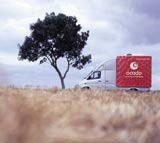Fight for shelf-definition
As Tesco reports escalating profits and market supremacy, Richard Clayton asks whether the supermarket chain’s competitors are able to compete with it

Soon, perhaps, the old adage about there being only two certainties in life will have to be amended. To death and taxes will be added a third inevitability, shopping at Tesco.
Last week’s half-year results, which showed the retailer’s profits were up 17 per cent and putting it on course for £1.7bn profits, sent the business pages into raptures.
Tesco pockets ‘more than £12 out of every £100 spent on the high street’ was a favourite headline. Its sales of toiletries, chart CDs and popular books outstrip those of category specialists like Boots the Chemists, HMV and WH Smith. International expansion is also progressing rapidly and proving highly lucrative.
With non-food – and particularly clothing – powering Tesco’s growth, Sainsbury’s homewares roll-out (DW 18 September) looks belated to many observers. Asda, of course, continues to advance, not least because of its George clothing brand.
But is Tesco’s market dominance unassailable? Can the chasing pack make any impression on the top dog, especially through design and branding?
‘Tesco has become a nigh-on impregnable retailing machine,’ says Verdict senior retail analyst Steve Gotham. ‘It’s that big and that good. Unless [Asda owner] Wal-Mart is given the go-ahead to buy Safeway, it would be very surprising to see its leadership position [threatened].’
Gotham thinks Tesco is not far from joining ‘a global elite of Wal-Mart, Carrefour and a couple of others’. It has achieved the demographic grail of ‘being all things to all people’.
‘Tesco’s brand qualities are that it’s brilliantly clever at juggling the balls of price, service, choice and quality at the same time,’ Gotham adds. ‘It was number two for a long time, but was obsessive about benchmarking and learning from Sainsbury’s [the then market leader]. Its management is very astute and won’t easily allow complacency. As a brand, it’s good at retaining the core essence of its street-trading origins.’
Innocence managing director Jez Frampton maintains that Tesco has cornered the market in what he calls ‘mass-premiumness – using design to make something ordinary seem extraordinary’.
Frampton is a non-executive director of Waitrose-backed on-line grocer Ocado and worked on the brand while at Interbrand. He admits ‘giving a premium leg up to an [essentially basic] offer is tricky’.
He points to Tesco’s track record in ‘design innovation’ – from introducing different types of trolleys to the way it employs in-store graphics within its often cavernous supermarkets.
Such sensitivity to marketing detail leads to another crucial factor. Where Tesco has been most adept, Frampton suggests, is in its ‘focus on service’.
To some extent, he says, Tesco ‘finished what Sainsbury’s started, taking the transition from own-label to own-brand’ a stage further. By emphasising service more than food, ‘it laid claim to far more potent and long-term differentiation’, he claims.
According to Gotham, customer insight is at the heart of Tesco’s business planning. It underpins the ‘value connotations’ of everything the retailer does and will help it to make inroads overseas.
Wren & Rowe managing director Paul Foulkes-Arellano endorses the formula. ‘Tesco realised the importance of quality and price long ago. It had good role models: Marks & Spencer for quality and Asda for pricing strategy. Tesco combined the best of both. No other supermarket has managed to do that.’
Sainsbury’s has been largely focused on refining its food offer. Tomorrow, it moves to entice the discerning gourmet shopper with a farmers’ market concept in Pimlico. Reprising Sainsbury’s Market at Bluebird (DW 13 March), in-store communication is by Woodward & Co and interiors are derived from the Conran & Partners’ template by an in-house team.
Despite serial ‘reinventions’, Sainsbury’s is searching for a viable positioning, Frampton believes. ‘Sainsbury’s branding is still lacking in confidence,’ adds Foulkes-Arellano. ‘Jamie Oliver [in the ad campaigns] is more important than the brand and everything about Sainsbury’s offer has been insubstantial.
‘It needs some international blood in the management team [to] play the game on a global level. The Sainsbury’s brand work has been all about pretty design, without the guts and drive of real marketing. They are still big enough to get it right, but the current UK retail market is all about being competitive, not holier than thou.’
Enterprise IG managing director John Mathers is more convinced by Sainsbury’s ‘commitment to quality’, but feels it must reassess what the brand stands for. In other words, it lacks a ‘big idea’.
Sainsbury’s is ‘right to reinforce its core food values’, says Gotham, ‘but it’s got to find a [better] way to talk about price and promotion. It’s lost a bit of price competitiveness.’
For Frampton, Sainsbury’s must prevent Tesco and Asda turning the UK grocery market into a two-horse race. If it ‘slips into a clear number three position’, Sainsbury’s risks losing the scale that is the pre-requisite of supermarket success – just as the convenience sector and home delivery are becoming two vital new fronts.
Tesco has ‘built people’s trust by promising on things and delivering time and again’, says Mathers. Its next challenge, according to Frampton, is establishing itself fully as a service brand, evolving beyond ‘grocery associations without losing sight of the ball’.
Mathers concludes, ‘Provided it doesn’t let people down, people will be amazed how flexible the Tesco brand could [ultimately] become.’
-
Post a comment




